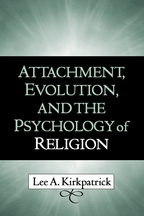Attachment, Evolution, and the Psychology of Religion
Lee A. Kirkpatrick
An Ambitious Agenda
Scientific
Comprehensive
Explanatory
Psychology of ...
Religion
A New Direction
Attachment Theory
Evolutionary Psychology
The Plan of This Book
2. Introduction to Attachment Theory
Backdrop
The Attachment System
Other Related Systems
The Phenomenology of Attachment
Individual Differences in Attachment in Childhood
Multiple Attachment Figures
Internal Working Models and the Stability of Attachment Patterns
Attachment in Adulthood
Attachment and Adult Romantic Relationships
Individual Differences in Adult Romantic Attachment
Factorial and Dimensional Models
The Formation and Development of Adult Love Bonds
An Alternative Approach to Adult Attachment
Attachment and Evolutionary Psychology
Summary and Conclusions
3. God as an Attachment Figure
Religion as Relationship
But Is It Really an Attachment Relationship?
Seeking and Maintaining Proximity to God
Proximity in Belief and Myth
Facilitating Psychological Proximity
Prayer
Other Religious Behaviors
God as a Haven of Safety
Crisis and Distress
Illness and Injury
Death and Grieving
God as a Secure Base
Phenomenology
Psychological Outcomes
Responses to Separation and Loss
Summary and Conclusions
4. More on Religion as an Attachment Process: Some Extensions and Limitations
Religion and Love
What Kind of Love?: Romantic Attachment versus
Attachment to God
God as a Parental Figure
Individual Differences in Images of God
God as a Benevolent Caregiver
God as Controlling and Demanding
Children's Beliefs about God
Beyond God: Extensions and Limitations
To Generalize, or Not to Generalize?
The Problem with Parsimony
Other Forms of Attachment (or Not) in Religion
Relationships with Other Supernatural Beings
Relationships with Religious Leaders
Relationships with Fellow Worshipers and Other Peers
Relationships with Groups
Nontheistic Religions
Summary and Conclusions
5. Individual Differences in Attachment and Religion: The Correspondence Hypothesis
Mental Models and the Correspondence Hypothesis
Correspondence in Childhood and Adolescence
Correspondence in Adulthood
Correspondence Across Cultures
Internal Working Models of Self and Others
Continuity from Childhood to Adulthood
The Socialized-Correspondence Hypothesis
The Two-Level Correspondence Hypothesis
"Socialization" as an Alternative Explanation
The Inadequacy of "Socialization" as Explanation
The Epidemiology of Beliefs
Individual Differences Revisited
Summary and Conclusions
6. God as a Substitute Attachment Figure: The Compensation Hypothesis
Individual Differences and Religious Conversion
Individual Differences in Childhood Attachment and Conversion
Sudden Religious Conversion
Other Evidence for a Compensation Model
A Two-Process Model
Individual Differences in Adult Attachment
Contextual Factors in Religious Change
Separation and Loss
Bereavement
Relationship Dissolution
Unavailability of Attachment Figures
Perceived Inadequacy of Human Attachment Figures
Cultural Factors
Summary and Conclusions
7. Attachment in Context: Introduction to Evolutionary Psychology
Evolutionary Psychology as a Paradigm or Metatheory
Adaptation and Natural Selection
Adaptations
"Selfish Genes" and Inclusive Fitness
Domain-Specificity and the Mental-Organs Model
Nature "versus" Nurture
Stone Age Minds in Modern Environments
Individual Differences in Evolutionary Context
Stable Environmental Differences
Direct Genetic Effects
Frequency-Dependent Adaptive Strategies
Early Environmental Calibration
An Example of Facultative Strategies: Human Mating
Are Evolutionary Explanations Unfalsifiable?
Some Illustrative Examples: Politics, Music, and Sports
Summary and Conclusions
8. Attachment Theory in Modern Evolutionary Perspective
Childhood Attachment in Modern Evolutionary Perspective
Parental Caregiving and Parent-Offspring Conflict
Individual Differences in Childhood Attachment
Attachment and Reproductive Strategies
The Belsky, Steinberg, and Draper Model
Individual Differences in Adult Attachment
Love Revisited
Love or Attachment?
Love as a Commitment Device
Implications for the Theory of Attachment and Religion
Correspondence and the RS Hypothesis
Compensation, Sudden Conversion, and the LM
Hypothesis
Summary and Conclusions
9. Religion: Adaptation or Evolutionary By-product?
Is There a Unique Religious Instinct?
Universality
Genetics
Neurology
Ethology
Problems with the Religion-as-Instinct View
The Problem of Identifying the Adaptive Function
Psychological vs. Reproductive Benefits
Group Selection vs. Selfish Genes
Costs vs. Benefits
Begging Questions
The Problem of Identifying the Design
The Problem of Establishing Special Design
Theoretical Conservatism and the Onus of Proof
Religion as an Evolutionary By-product, Not an Adaptation
Adaptations vs. Evolutionary By-products
Religion as an Evolutionary By-product
An Analogy: Games and Sports
Summary and Conclusions
10. Beyond Attachment: Religion and Other Evolved Psychological Mechanisms
Power, Status, and Intrasexual Competition
Supernatural Beings as Power Figures
Human Religious Leaders as Power Figures
Kinship
Supernatural Beings and Religious Leaders as Kin
Ingroup Members as Kin
Reciprocal Altruism and Social Exchange
Supernatural Beings as Social-Exchange Partners
Mutual Helping and Social Support
Morality and Ethics
Coalitional Psychology
In-Group Cooperation and Morality
Out-Group Discrimination and Conflict
Supernatural Beings as Coalitional Partners
Summary and Conclusions
11. The Cognitive Origins of Religious Belief
Evolved Mechanisms for Thinking about the Natural World
Naive Physics and Psychological Animism
Naive Biology and Natural Kinds
Naive Psychology and Theory of Mind
The Psychology of Complex Thinking: How the Mind Works
The Cognitive Building Blocks of Religious Belief
Animism
Psychological Essentialism
Anthropomorphism
Why Religious Beliefs Succeed
Evolved Psychological Mechanisms: Calibration and Bias
Religious Beliefs: Combining the Intuitive and the Counterintuitive
Beyond Religion: Other Forms of Thought and Belief
Parapsychology and Other Supernatural Beliefs
Commonsense Knowledge and Reasoning in Everyday Life
Science
Summary and Conclusions
12. Beyond Genes: Learning, Rationality, and Culture
Natural Selection, Genes, and Inclusive Fitness
From Genes to Memes
Individual Learning, Reinforcement, and the Pleasure Principle
Complex Reasoning and Higher-Order Cognitive Processes
Social Learning, Socialization, and Cultural Transmission
Cooperation, Competition, and Manipulation
Memes and Viruses of the Mind
Science Revisited
Summary and Conclusions
13. Toward an Evolutionary Psychology of Religion
A Précis in (More or Less) Reverse
Evolutionary Psychology and Adaptation
From Genes to Behavior
Religion as an Evolutionary Byproduct
The Psychological Origins of Religious Belief
The Social Psychology of the Supernatural
Conclusion
An Evolutionary Psychology of Religion for the Future
A Theoretically Rich "Psychology" of ...
A Paradigmatic, Interdisciplinary Science
A Coherent Model of Universality vs. Individual Differences
Beyond Description to Function
Religious Nature Carved at its Joints
Avoiding Major Pitfalls in the Psychology of Religion
Summary and Conclusions



